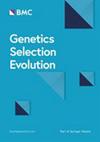Coinfection affects the phenotypic but not genetic resistance of cattle to common parasites
IF 3.1
1区 农林科学
Q1 AGRICULTURE, DAIRY & ANIMAL SCIENCE
引用次数: 0
Abstract
Genetic variation in host resistance to individual parasites is well documented in cattle; however, the influence of coinfection on these genetic responses to selection remains poorly characterized. In particular, it is unclear how concurrent exposure to multiple parasite species alters phenotypic expression, heritability estimates, or genetic correlations between resistance traits. To address these gaps, we evaluated the impact of coinfection on the genetic architecture of parasite resistance in yearling Nellore calves naturally challenged with ectoparasites (ticks) and endoparasites (gastrointestinal nematodes and Eimeria spp.). Using longitudinal parasite count data, we estimated genetic parameters and examined how coinfection modifies both individual parasite resistance and the genetic correlations among traits. Our results confirmed that coinfection is a common phenomenon (almost ¾ of samples contained multiple parasites) and that resistance to individual parasites is a heritable trait. Furthermore, coinfection with Eimeria spp. reduced the phenotypic resistance to nematodes, and vice versa. We observed diverse genetic associations for resistance to different parasites, including positive, negative, and nonsignificant correlations. Notably, coinfection had no significant effect on genetic resistance to individual parasites, nor did it alter genetic variances or associations between resistance to different parasites. While coinfection may influence the outcomes of nongenetic parasite control programs, its impact on genetic control strategies appears minimal. In other words, genetic resistance of Nellore cattle to three key parasite species appears to be robust and unaffected by the presence of coinfection.共同感染影响牛对常见寄生虫的表型抗性,但不影响遗传抗性
在牛中,宿主对单个寄生虫的抗性遗传变异已得到充分记录;然而,共同感染对这些遗传选择反应的影响仍然不清楚。特别是,目前尚不清楚同时暴露于多种寄生虫物种如何改变表型表达、遗传力估计或抗性性状之间的遗传相关性。为了解决这些空白,我们评估了在自然感染外寄生虫(蜱虫)和内寄生虫(胃肠道线虫和艾美耳球虫)的一岁Nellore犊牛中,共感染对寄生虫抗性遗传结构的影响。利用纵向寄生虫计数数据,我们估计了遗传参数,并研究了共感染如何改变个体寄生虫抗性和性状之间的遗传相关性。我们的研究结果证实,共感染是一种常见现象(近3 / 4的样本含有多种寄生虫),对单个寄生虫的抗性是一种遗传特征。此外,与艾美耳球虫共感染降低了对线虫的表型抗性,反之亦然。我们观察到对不同寄生虫抗性的不同遗传关联,包括正相关、负相关和不显著相关。值得注意的是,共同感染对单个寄生虫的遗传抗性没有显著影响,也没有改变遗传变异或对不同寄生虫的抗性之间的关联。虽然合并感染可能影响非遗传寄生虫控制计划的结果,但其对遗传控制策略的影响似乎很小。换句话说,Nellore牛对三种主要寄生虫的遗传抗性似乎很强,并且不受合并感染的影响。
本文章由计算机程序翻译,如有差异,请以英文原文为准。
求助全文
约1分钟内获得全文
求助全文
来源期刊

Genetics Selection Evolution
生物-奶制品与动物科学
CiteScore
6.50
自引率
9.80%
发文量
74
审稿时长
1 months
期刊介绍:
Genetics Selection Evolution invites basic, applied and methodological content that will aid the current understanding and the utilization of genetic variability in domestic animal species. Although the focus is on domestic animal species, research on other species is invited if it contributes to the understanding of the use of genetic variability in domestic animals. Genetics Selection Evolution publishes results from all levels of study, from the gene to the quantitative trait, from the individual to the population, the breed or the species. Contributions concerning both the biological approach, from molecular genetics to quantitative genetics, as well as the mathematical approach, from population genetics to statistics, are welcome. Specific areas of interest include but are not limited to: gene and QTL identification, mapping and characterization, analysis of new phenotypes, high-throughput SNP data analysis, functional genomics, cytogenetics, genetic diversity of populations and breeds, genetic evaluation, applied and experimental selection, genomic selection, selection efficiency, and statistical methodology for the genetic analysis of phenotypes with quantitative and mixed inheritance.
 求助内容:
求助内容: 应助结果提醒方式:
应助结果提醒方式:


